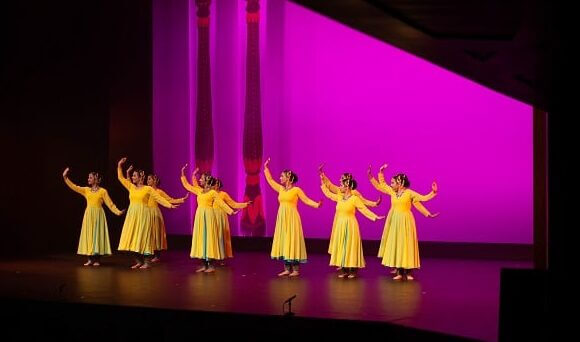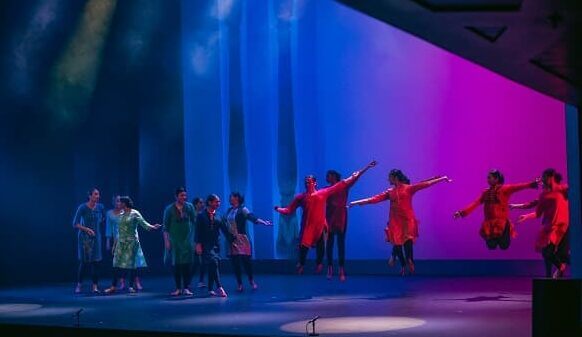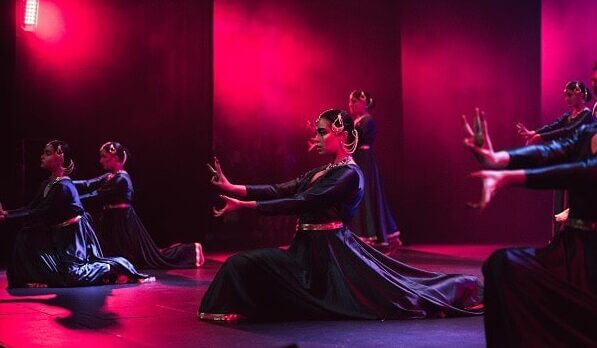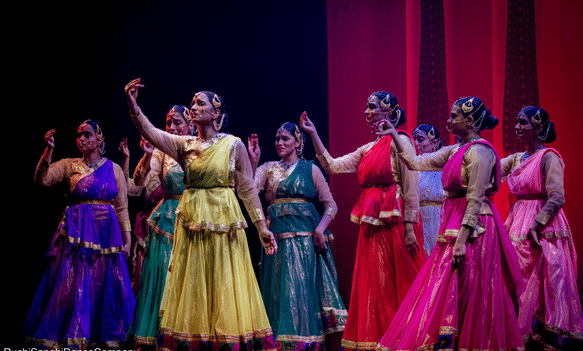Leading Sydney dancer Ruchi Sanghi’s latest production Laasya: In Her, All the Power was as beautiful as it was thought-provoking.
With over a hundred dancers, it succeeded in keeping the feet tapping even as the profound messages made their mark – a happy amalgam of traditional pieces from the Kathak repertoire, and some experimental works reflecting contemporary realities.
The term ‘laasya’ refers to a delicate and feminine dance, often ascribed to Parvati’s response to her husband Shiva’s thunderous Tandav, a dance of transformation.
This was wonderfully ideated in Ruchi Sanghi’s Laasya – a thematic presentation, which became a study of women’s response to societal change. Coming so close to International Women’s Day in early March, the production looked at women’s changing attitudes to the world around them.

Laasya: The traditional
And so it was befitting that the performance began with the Tandav, establishing the energies that are needed for change.
A thousand bells tinkled in unison in the taranas, ranging from the 13th-century Sufi poet Amir Khusro to the 20th-century dancer Natraj Gopi Krishna.
Next up in Virah, the dancers sat suspended in a circular formation in a state of separation, expressing the pain of love. It was a canvas of intense abhinaya, holding a mirror to the emotional conflict in the state of love. And then, as each dancer rose in turn, unfolding the torment of her body and heart, they blossomed like the petals of a flower tossing in the wind—an exhilarating opening, as it were, of the collective feminine psyche.
What else can follow but a gentle and joyous thumri – the graceful steps, the mischievous glances, and the flick of their ghagras holding the audience in thrall.
Having finally come into her own, the stage was set for Woman’s more powerful expressions of identity.

Laasya: The contemporary
Three very striking pieces had the audience cheering in appreciation.
A thought-provoking piece was Nachi Nachi – A Dance Battle, a confrontation of sorts between two dance groups, one group practising the traditional genre and the other a modern style, representing a challenge faced by many young dancers today. Do we give up our traditions to fit in with our peers, or do we stand for our culture and values and take pride in them? The reference to the deeply polarised world in which we live, was unmistakable. The choreography enhanced every sentiment experienced by the dancers and their internal conflict.
Another piece that represented the external conflict of our world was the Army, featuring the heart-wrenching strength of women that serve in our military forces. Music that brought to life the reality of war and conflict was further embellished by the staccato movements of the choreography and the costumes of the dancers.
The audience held their breath when the lights next appeared to present faces completely masked with fabric. Laga Chunari Mein Daag depicted the scenarios in life when women enshroud their emotions under societal pressure. It was appropriate and hopeful to see the piece take a turn with the women breaking free of their visors and revealing their true selves.
The underlay of conflict gradually became clear: in military combat (featuring of course, women in war in this instance); between tradition and modernity; between conforming and not conforming; between hiding our pain or struggles and baring it all to find catharsis.
Perhaps these were Ruchi Sanghi’s interpretations of the transitioning attitudes to womanhood.
Equally, they were her interpretations also of transitions in her craft.

“We felt the production demanded different ways of showing strong women,” Ruchi told Indian Link. “Also, thanks to my daughter Niharika, we chose a range of pieces (contemporary to traditional) to demonstrate how dynamic and rich kathak is as a dance form.”
They also felt that the common perception of our classical dances as boring needs to be challenged, as the younger generation is moving away from these dance forms and embracing western styles.
Ruchi Sanghi’s Laasya: In Her, All the Power was staged as a charity project for the organisation Saaya, raising funds for TAD Sydney and Harman Foundation, Sydney. Hari Sallakonda, on behalf of Saaya was deeply grateful for the considerable funds raised.
Carefully picked music and costumes, seamless transitions between items, lighting by Sagar Agashe and commentary by Sarita Agashe and Viral Hathi showcased Laasya as a shining jewel in Sydney’s classical scene.
Read More: Hamsa Venkat’s Utsav: ‘Dance has that power to soothe’




